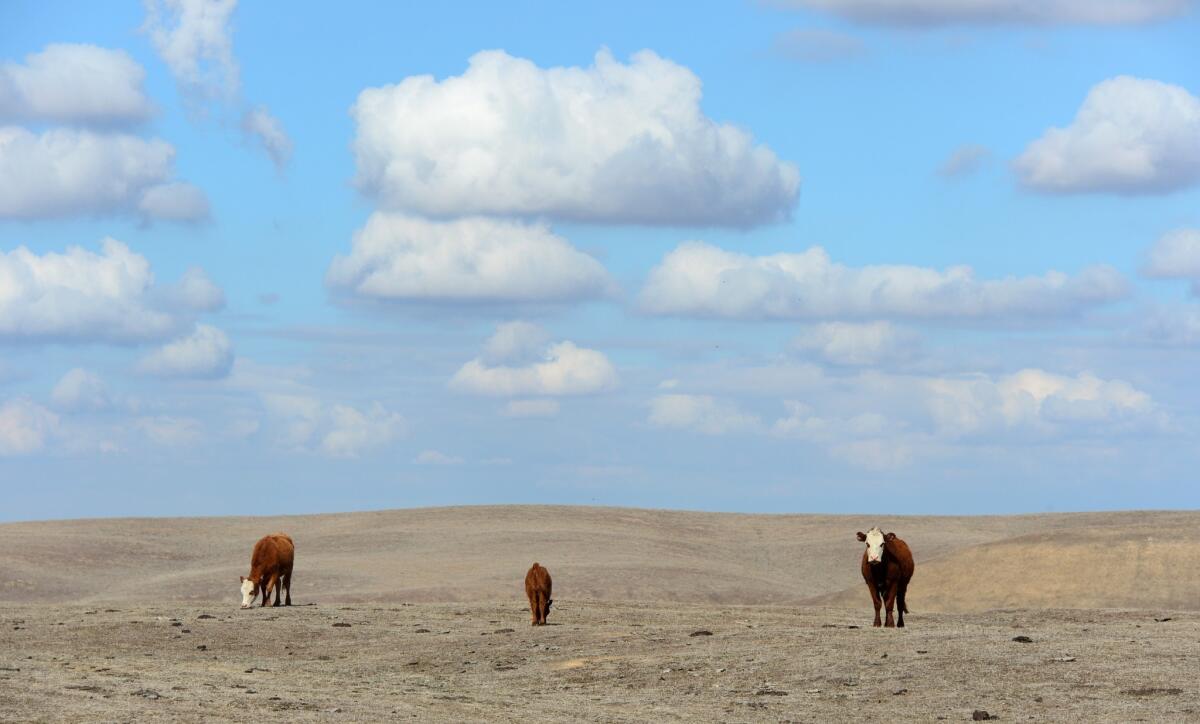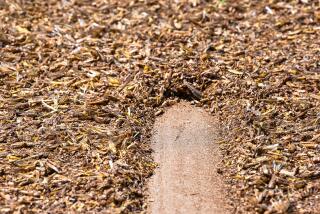Another drought victim -- grass-fed beef

- Share via
How hard is the drought hitting California farmers? Here’s one more example -- Marin Sun Farms, one of the pioneers of grass-fed beef, is going to start feeding some of its cattle on grain. There’s just not enough grass to keep them alive.
“We kept thinking we’d be fine, but we didn’t get any rain and we didn’t get any rain and we just reached a breaking point where we decided we had to pull out this other marketing plan,” says Marin Sun owner David Evans, who has been raising grass-fed beef on his family’s fourth-generation Marin County ranch since 1998.
The company’s marketing director, Jeff Bordes, says the decision was wrenching. “Marin Sun Farms has been built on 100% grass-fed beef since it started. It definitely has been a tough move for us. What this drought has done is really force us to diversify our program when we’re facing seasons like this winter. It was either do this or go out of business.”
Grass-fed beef comes from cattle that have been fed only grass and hay -- most beef cattle are fed grass for the majority of their lives but fattened up on grain in feed lots before slaughter. Fans of grass-fed beef prefer it because they say it has health and environmental benefits.
Marin Sun will still offer grass-fed beef when it is available, and it is going to offer special color-coded packaging to make it clear to its customers what they are buying. Grass-fed beef will be packaged in green wrapping, beef from pastured animals supplemented with grain and hay will be in yellow wrapping, and pen-raised animals feed on hay and grain will be in black wrapping.
Anya Fernald, owner of Belcampo Meat, another sustainable beef purveyor, is feeling the drought too, but she says she’s sticking to her grass-fed guns. Even if that might mean shipping 2,000 heads of her Northern California herd to wetter grazing grounds in the Dakotas. And she’s aggressively culling her herd to get the numbers down.
“This drought has been devastating for us,” she says. “Our production costs have more than doubled.
“We try to have 100% nutrition coming from our own grasses, and also have hay that we grow for reserve fund. In this case with the drought, we’ve gone through that reserve and have had to buy hay from the outside. But if you’re buying organically certified hay, there’s not very much out there.
”We’re just trying to be out of the box and figure out to make this work. But the big question is ‘Is this the new normal?’”
Mike Gale, a long-time grass-fed beef advocate at Chileno Valley Ranch in west Marin County, says he’s never seen anything like this winter.
“There’s just no grass on the fields,” he says. “We haven’t had grass since last May. Usually at this time of year our grass is knee-high or 18 inches. The cattle are just wallowing in it. But even with the rain we got last month, we’ve got no grass, the seeds just never germinated.
“This has been a very unusual experience. Nobody has ever gone through something like this before.”
Still, says Gale, who sells beef from his small herd in quarters, halves and whole carcasses to families on his mailing list, he’s going to stick with grass and hay.
Marin Sun, which just bought the troubled Ranch Feeding Corp. slaughterhouse and is planning to open it up to an all-sustainable meat program, has known for some time that it might have to start supplementing, says owner Evans, because of the seasonality of grass-fed beef. For the most part, the animals are fattened up on winter grass and slaughtered during the summer.
“The possibility has always been on my mind because of the seasonality. We knew that as we were growing that eventually we would have a shortage of 100% grass-fed beef in the winter, or we would have to supplement and diversify.
“This is fine. If people are really orthodox about eating only grass-fed beef, then they should only eat it seasonally. But we have a number of customers who still want meat year-round and are interested in high-quality meat but are open to using a pasture-raised animal that gets some supplemental grains as long as it’s raised with all the other attributes we bring.
“Our whole issue is not just grass-fed, but building a more sustainable food model. And that might include seasonal feeding of grain.”
ALSO:
Mr. Cronut himself comes to the Grove for a day
Can’t get enough Pappy? Here’s a dinner for you
Chef of the moment: Hotel Bel-Air’s Hugo Bolanos
More to Read
Eat your way across L.A.
Get our weekly Tasting Notes newsletter for reviews, news and more.
You may occasionally receive promotional content from the Los Angeles Times.











